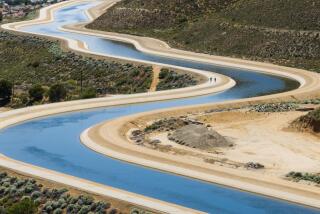Critical Water Shortage Looms, State Warned
- Share via
Southern California’s robust economy is outstripping its water supply, local water officials warned Tuesday, and failure to find new sources and protect endangered old sources could leave the region facing large, chronic shortages in a few years.
In testimony before the state Water Resources Control Board in Irvine, Metropolitan Water District officials and other beneficiaries of the State Water Project said their municipal and industrial customers face a 1990 water gap of 280,000 acre-feet, about 5% of demand, despite conservation efforts.
Those same consumers, who luxuriated in a 1.3-million acre-foot surplus seven years ago, may face a 1.4-million acre-foot deficit--22% of demand--20 years from now, largely because of economic and population growth predicted by Southern California planning agencies.
One acre-foot of water contains about 326,000 gallons, enough, according to Tim Skrobe, an MWD spokesman, to supply two average Southland families for a year.
The dire predictions occurred as the five-member state water board arrived in Southern California in pursuit of its historic reexamination of water rights in the San Joaquin-Sacramento Delta, ending ultimately in July, 1990, with a water-rights decision that is intended to establish a permanent system for allocating delta water.
The Irvine hearings will continue through Friday.
The delta, an expansive estuary east of San Francisco, holds most of the state’s surface water and is the source of 40% of the drinking water for semi-arid Southern California.
Agencies served by the 20-year-old State Water Project--especially those in Southern California--are seeking to increase the amount of water diverted south from the delta, through which the Sacramento and San Joaquin rivers flow on the way to San Francisco Bay and the Pacific Ocean.
Many Northern Californians want the diversions maintained at their present levels or reduced to protect delta farmers, local drinking-water quality and the plethora of wildlife dependent on fresh water in the area.
River Flows in Reverse
Sometimes, so much water is pumped out of the delta that a part of the San Joaquin River flows in reverse, pulling brackish water in from the bay.
Delta water is seen as particularly urgent because other traditional water sources are endangered. Mono Lake and other Owens Valley water sources, for example, are threatened by several lawsuits, and some local ground water is either being pumped out faster than rains replenish it or has been polluted and may not meet stringent federal water-quality standards. At the same time, California has seen its share of Colorado River water cut in half.
“We’re having to learn to live with a lot of uncertainty,” lamented Duane L. Georgeson, assistant general manager of the Los Angeles Department of Water and Power.
Because of this uncertainty, the State Water Project beneficiaries said in a foot-thick stack of exhibits submitted Tuesday, a bigger share of delta water is “critical” to meeting the growing water needs of Southern California.
“All other water supplies are being utilized to the maximum extent,” the group wrote in one exhibit. “The delta is the primary source of additional water supplies to meet growing demands for water.”
That assertion was challenged by Tom Zuckerman, a Stockton lawyer speaking for delta farmers. He noted the figures given by Southern California water agencies assume near-drought conditions and do not count on being able to buy excess water from elsewhere, such as Colorado River water from Arizona or Nevada.
Georgeson countered that such supplies are not dependable enough for planning purposes. Besides, he and others said, demand still will grow despite efforts to conserve water and despite a loss of agriculture, at least in the 10 counties south of the Tehachapi Mountains.
Cressey H. Nakagawa, representing the Contra Costa Water District, contended that no allocation could support the growth projections being put forth by Southern California officials.
“At some point,” he said, “a responsible planning agency is going to have to stand up and say there are some limits.” Current assumptions, he said, “are based on an unlimited resource that doesn’t exist.”
Uncertain Water Supplies
Effects of uncertain water supplies are being seen in the southern part of the state, Southland officials assert. The Metropolitan Water District cited one think tank study contending that an electronics firm built a $200-million plant in Oregon rather than San Diego because of fears about water supplies. Stuart Shaffer, assistant director of the San Diego Assn. of Governments, said changes are seen even in city zoning plans.
“Up to now, the view (among city officials) has been we have to supply the water required by the population,” he said. “Soon we’ll start looking at the possibility of limiting the population to match the water supply available.”
Such discussions will begin in his county this summer, he said.
Water consumption in the intensely cultivated San Joaquin Valley will be covered at hearings scheduled to begin Aug. 24 in Fresno. Other hearings will continue off and on for three years.
More to Read
Sign up for Essential California
The most important California stories and recommendations in your inbox every morning.
You may occasionally receive promotional content from the Los Angeles Times.










